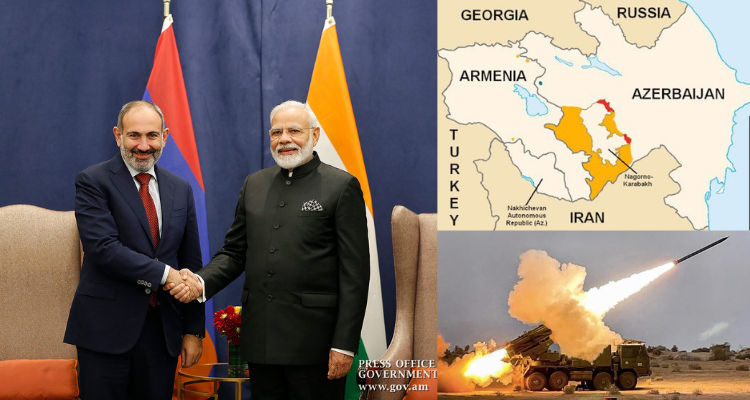Baku, Azerbaijan, August 01: According to reports from Azerbaijan news platforms, India’s indigenous Pinaka multi-barrel rocket launchers have been delivered to Armenia via Iran, sparking diplomatic protest from its arch-rival, Azerbaijan.
This major shipment marks India’s growing strategic presence in the decades-old Nagorno-Karabakh conflict and has the potential to position India as a significant arms supplier to Armenia, possibly replacing Russia.
Videos of a camouflaged convoy moving through Iran’s Nurduz border checkpoint into Armenia have emerged, with claims that it was carrying military cargo, likely delivered to the Iranian port of Bandar Abbas from the Caspian Sea’s eastern coast.
These trucks were reportedly loaded with weapons and ammunition from India, indicating the strengthening military-technical cooperation between India and Armenia.
Nagorno-Karabakh Conflict:
The disputed region of Nagorno-Karabakh has been at the center of an ethnic and territorial conflict between Armenia and Azerbaijan. This region is predominantly inhabited by ethnic Armenians but is internationally recognized as part of Azerbaijan.
The roots of the conflict can be traced back to the early 20th century. However, the current hostilities escalated in 1988 when Karabakh Armenians demanded the transfer of the region from Soviet Azerbaijan to Soviet Armenia.
In late 2020, the region witnessed a large-scale 45-day war, known as the Second Nagorno-Karabakh War, which led to thousands of casualties and a significant victory for Azerbaijan. Russia brokered a ceasefire agreement to halt the hostilities.
However, since December 2022, Azerbaijan has blockaded the Republic of Artsakh, de-facto pro-Armenian administration of Nagarno-Karabakh, effectively cutting it off from the outside world. This blockade violates the 2020 ceasefire agreement and international legal rulings.
India’s Entry into the Conflict:
As earlier reported by Indic Worldview, Armenia has turned to India to beef up its defenses with the purchase of multiple military systems amid continuing tensions with Azerbaijan, which is seen as an ally of Pakistan and Turkey.
In 2017, Turkey, Azerbaijan, and Pakistan issued a joint statement, establishing security cooperation and building further on previous bilateral military aid arrangements. Azerbaijan later deployed Turkish drones in the 45-day war with Armenia in 2020 and is believed to be in talks with Pakistan to buy the JF-17 fighter aircraft.
With growing proximity to India’s arch-rival Pakistan and strategic competitor in West Asia, Turkey has led to India’s decision to enter the conflict as a major arms supplier for Armenia
Earlier, Armenia bought four indigenous ‘Swathi’ weapons locating radars in 2020 from India, which was delivered in the backdrop of its conflict with Azerbaijan.
Late last year, Armenia had ordered a mounted 155mm 39-caliber artillery system manufactured by Bharat Forge, a private defense firm part of Pune-based conglomerate Kalyani Group.
In September last year, Armenia signed a government-to-government contract with New Delhi for the indigenous Pinaka multi-barrel rocket launchers, anti-tank missiles, and ammunition.
the Pinaka system is considered at par with the US HIMARS. The DRDO developed the Pinaka system as a replacement for the Russian GRAD BM-21, which also equips the Armenian armed forces.
Reports of Armenia was eyeing more defense deals with India including procurement of drones, counter-drone measures, and loitering munitions, besides mid-range surface-to-air missile (SAM) systems like the Akash developed by the DRDO (Defence Research and Development Organisation).
Beyond Arms Supply:
India’s partnership with Armenia extends beyond arms supply. It aims to fill the strategic vacuum created by Russian inactivity in the region while challenging Turkey’s influence in the neighborhood.
India, Iran, and Armenia have collaborated to boost the International North-South Transport Corridor (INSTC) and another corridor connecting Russia with Europe via Armenia.
The Pinaka rocket launchers could be a game changer for Armenia, providing a shield against Turkish drones, and India’s diplomatic support becomes crucial at international platforms.
India’s foray into the Nagorno-Karabakh conflict complements its status as a leading arms exporter, with recent deals with more than 85 countries worldwide. The Indian government aims to achieve $5 billion in defense equipment exports by 2025, further solidifying its presence in the global arms market.
India’s strategic presence in the Nagorno-Karabakh conflict not only cements India’s position as a global arms exporter but also strengthens its geopolitical influence in the Caucasus region.






